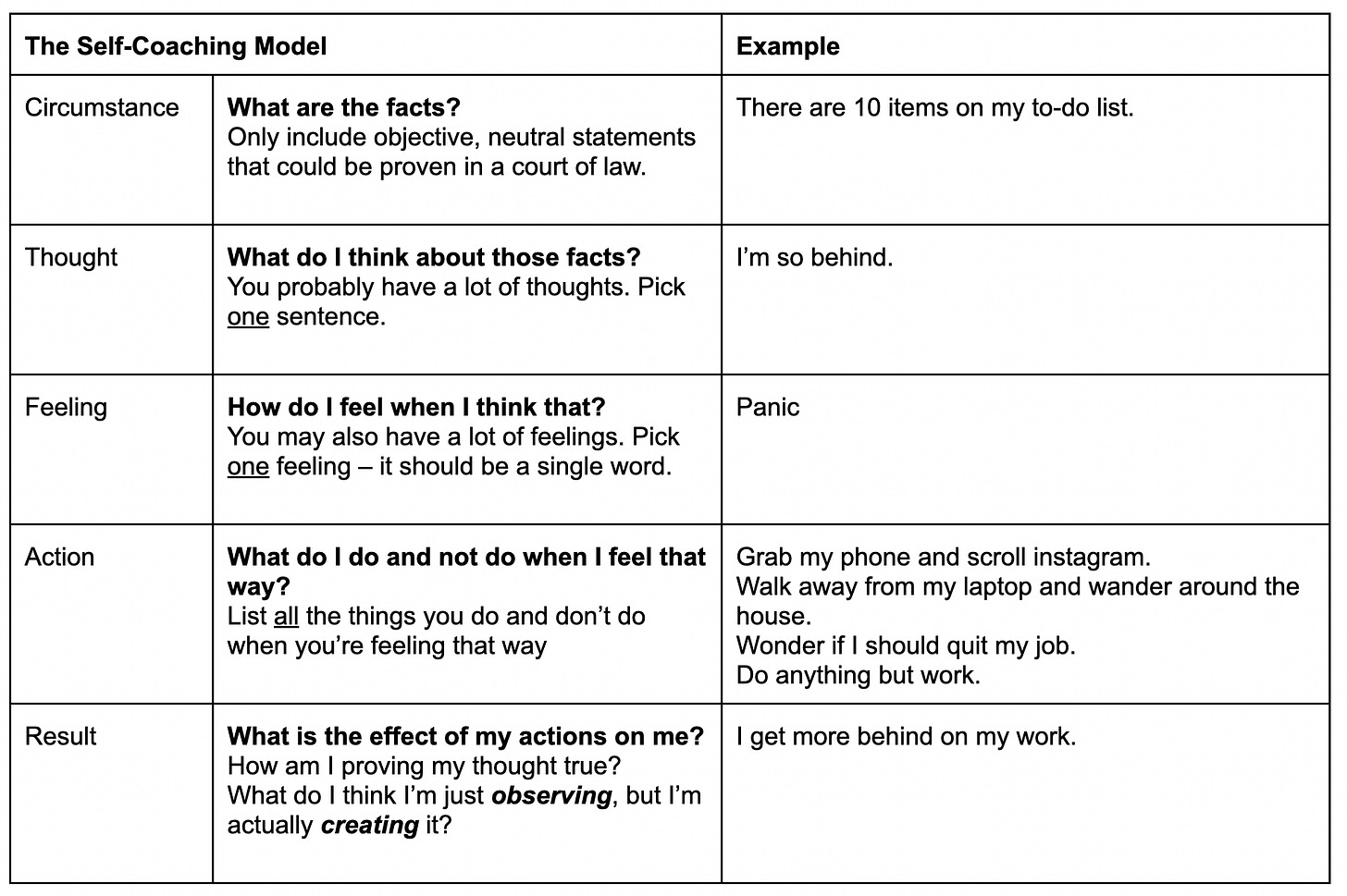The Framework That Changed My Life
🎧 Listen to this article | 📸 Instagram | 💌 Newsletter | 📞 Book a consult | 👋🏽 New? Start here
I’ve been drawing on a lot of concepts and ideas as I’ve been writing these pieces, but this is the fundamental bedrock of it all. This is the problem-solving framework that changed my life. Here it is:
Let’s look at an example - this is a model I’ve spent a lot of time living in:
This is a remarkable analysis of my “behind-ness.”
All my life, I thought my behind-ness was just a fact. I thought I was just observing “oh I’m so behind.”
But I’m not. The only fact in this situation is that I have a list with some stuff on it.
My “behind-ness” is created by me. And when I believe I’m behind, I feel panicked, I walk away, and I get more behind, per my own definition.
I think I’m just observing something, but I’m actually creating it.
It is very, very easy to believe that circumstances create feelings, actions, and results. This is why, when we’re faced with a problem, we leap to changing our circumstances.
“I just need a more chill job and I’ll be less stressed.”
“I need someone to give me a deadline, then I’ll be productive.”
“If I just lose the weight, then I’ll be happy.”
“I need to be in a relationship, or not in one, or in a different one.”
But this approach completely misses the root cause of your problem.
If you want to stop being so behind, you have to stop thinking that you’re so behind. That’s it.
You can change jobs and extend deadlines and remove things from your to-do list, but none of that addresses the underlying thought-habit that you’ve fallen into. None of that addresses the filter you’ve put on the world.
So when are you supposed to change your circumstance and when are you just supposed to change your thoughts?
First of all, you’re allowed to do anything you want anytime you want. Go nuts. The point is just that changing your circumstances won’t fix the actual underlying cause of how you’re feeling and acting.
So when it comes to changing circumstances vs. changing thoughts, it’s not an OR — it’s an AND. I know the collection of thoughts that make me feel panicked while working. And I know that every single one of those is probably going to come up as I try to build this career too. So I’m going to work on them — AND I’m going to build this career.
Why change your circumstances ever? Because you want to! I want to be a writer. I want to weigh less than I weigh right now. I want to be in a long-term relationship. Going after what you want is not a bad thing — it’s literally the best thing.
We only run into trouble when we believe that getting what we want (and only getting what we want) will cause us to finally feel a certain way forever. That’s a promise that never holds up — just ask lottery winners or people who lost weight or anyone who made partner at a consulting firm.
The reason that just getting what you want doesn’t make you feel better is that thoughts are habits. If you’re in the habit of being stressed about money, or thinking you’re fat, or being panicked about work, that habit will just keep on going, no matter how many lotteries you win, pounds you lose, or promotions you receive. (Minus that brief, glorious glow when you appreciate the change — before it becomes normal to you.)
So doing the work in parallel — working on your thoughts and working toward your goals is the surest way to make sure that Future You actually gets what Current You wants so badly. (And bonus — you get to start feeling better now, not later.)
Coming up in future posts:
Cool I get it — but how do I actually change my thoughts?
Buckle in — there are so many ways. But first — and you’re going to hate this — there’s no need to be in a rush to change them. Because the first thing to do is to really, really listen to them.
Wait, is the goal just to be happy with everything all the time?
Nope, not at all! There are plenty of situations where you want to be angry or disappointed or sad. But you can still ask yourself how you want to think and react to get what you want in a crappy situation.
If everything is a thought then what’s real? What should I think?
It’s up to you! Thoughts are just perspectives — they’re like assumptions in a model. Surface the ones you have right now. Decide which ones you want to use going forward. There’s no model without assumptions, but you don’t have to stick with the ones you’ve got.




Very sage! I’m eating ice cream and reading this instead of working!